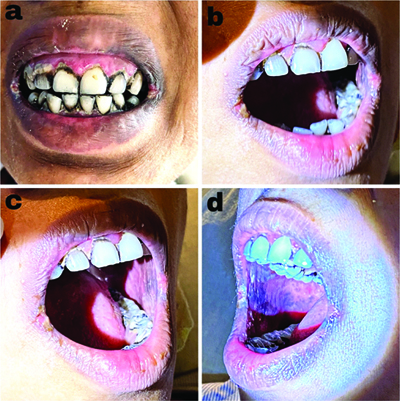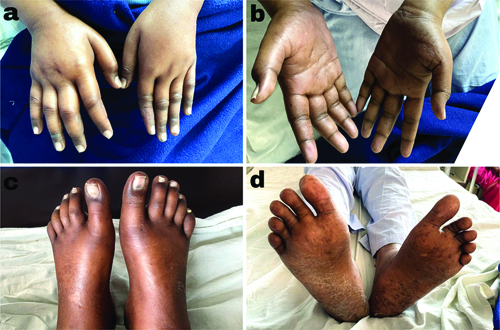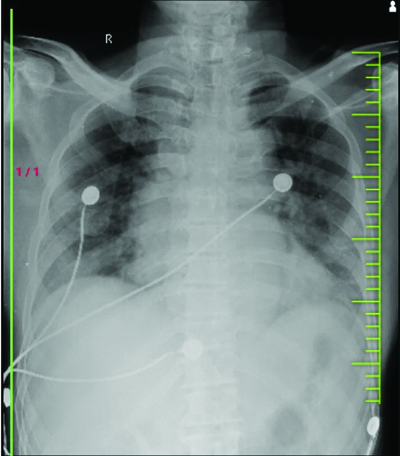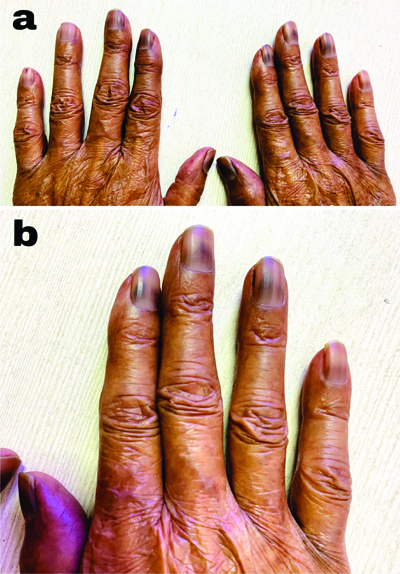Capecitabine-induced Hand-foot Syndrome with Hyperpigmentation on Oral Mucosa and Nails: A Rare Entity
Suprit Malali1, Sourya Acharya2
1 Junior Resident, Department of Internal Medicine, Jawahar Lal Nehru Medical College, Datta Meghe Institute of Higher Medical Education and Research, Sawangi, Meghe, Wardha, Maharashtra, India.
2 Professor, Department of General Medicine, Jawahar Lal Nehru Medical College, Datta Meghe Institute of Higher Medical Education and Research, Sawangi, Meghe, Wardha, Maharashtra, India.
NAME, ADDRESS, E-MAIL ID OF THE CORRESPONDING AUTHOR: Dr. Suprit Malali, Junior Resident, Department of Internal Medicine, Jawahar Lal Nehru Medical College, Datta Meghe Institute of Higher Medical Education and Research, Sawangi, Meghe, Wardha-442004, Maharashtra, India.
E-mail: supritbm@gmail.com
Adenocarcinoma,Inflammatory,Positron emission tomography
Dear Editor,
We present two cases of Capecitabine-induced Hand-Foot Syndrome (HFS), hyperpigmentation on the oral mucosa, and nails.
Case 1
A 28-year-old female, previously diagnosed with stage 4 left-sided inflammatory breast cancer, along with metastases to the right breast and skeletal sites one year ago, as confirmed by trucut biopsy and Positron Emission Tomography scan (PET), presented to our clinic with complaints of fatigue and generalised weakness persisting for the last month. The patient does not report any co-morbidities. Further clinical assessment and investigation are warranted to address the current symptoms and determine the appropriate course of management for the underlying cancer and associated symptoms. She received four cycles of injectable capecitabine and cyclophosphamide and later was shifted to oral chemotherapy with the same drugs for the last six months. All routine investigations such as complete blood count, liver function test, kidney function test, coagulation profile, and random blood sugar were within normal limits. The chest X-ray was normal. The Electrocardiogram (ECG) was suggestive of normal sinus rhythm. Upon examination, vitals were normal, and hyperpigmented patches and macules with blackish to grey colour were seen in the oral mucosa, gingival mucosa, teeth, palmar and dorsal aspects of hands, and plantar and dorsal aspects of the foot [Table/Fig-1a-d,2a-d].
a) Image showing hyperpigmented lesions involving the gingival mucosa and teeth; b-d) Image showing hyperpigmented patches in the angle of mouth and buccal mucosa (b&c).

a) Image showing hyperpigmented knuckles; b) Showing hyperpigmented palmar creases and scattered macules in palm; c) Showing hyperpigmented patches on foot and nail of right great toe; d) Showing scattered hyperpigmented macules with scaly lesions on plantar aspect of foot.

Case 2
A 60-year-old female presented to our emergency department with complaints of breathlessness (without aggravating or relieving factors), cough with expectoration, and low-grade fever for the past five days. She was a known case of adenocarcinoma of the esophagus and had received nine cycles of chemotherapy with capecitabine and cisplatin. During examination, the patient exhibited an SpO2 level of 90% in ambient temperature conditions, while all other vital signs remained within normal ranges. Chest auscultation revealed bilateral fine crepitations. No abnormalities were detected in other organ systems. All routine investigations were performed. The leukocyte count was raised (15,400 cells/cu mm), while liver function tests, kidney function tests, and random blood sugars were within normal limits. The chest X-ray suggested bilateral scattered haziness [Table/Fig-3]. The ECG showed normal sinus rhythm. On local examination, it was noticed that the patient had hyperpigmented lesions on the nails of her hands [Table/Fig-4a,b].
Chest X-ray showing of bilateral scattered haziness.

a and b) Image showing hyperpigmented lesions on the nails of both hands.

Capecitabine is an oral chemotherapy drug frequently used to treat metastatic breast cancer and is also recommended as a first-line treatment for gastrointestinal malignancies. As a prodrug, it is rapidly absorbed by the liver and converted to 5-fluorouracil (5-FU) by the abundantly expressed thymidine phosphorylase enzyme in tumour tissue. Hand-foot Syndrome (HFS) is a side-effect of capecitabine characterised by skin hyperpigmentation, hyperkeratosis, and palmar-plantar desquamation [1,2].
The pathophysiology of oral mucosal hyperpigmentation caused by capecitabine is poorly understood and underreported in the literature. Additionally, earlier research has questioned whether hyperpigmentation of the oral mucosa is merely another symptom of HFS or if it exhibits a distinct behaviour [1,3]. The purpose of the letter is to report a case of oral mucosal hyperpigmentation in a cancer patient who had been treated with oral capecitabine as an antineoplastic therapy.
The cause of capecitabine-induced nail changes is unknown, but immunosuppression and subsequent nail bed colonisation, disruption and change of the nail plate, loss of adhesion between the nail plate and nail with subungual oedema, as well as erosive and inflammatory processes, may all play a role in causing melanonychia [4,5].
One extremely uncommon side-effect of capecitabine is hyperpigmentation of the oral mucosa and nails [1]. It is still unknown if it is a component of an early HFS manifestation or if it exists independently. We present a case of oral mucosal and nail hyperpigmentation that occurred prior to the clinical diagnosis of HFS and may be an early indicator of this condition. Capecitabine-induced hyperpigmentation of the hands and feet is a widely recognised and well-documented side-effect [1]. However, the occurrence of capecitabine-induced hyperpigmentation affecting the oral mucosa and nails is considered rare and distinctive. Understanding this uncommon manifestation is crucial as it enables early identification of the side-effect. Such awareness is valuable in facilitating timely intervention, potentially leading to a modification of the chemotherapy drug if deemed feasible. Therefore, having knowledge of this unique aspect of capecitabine-induced hyperpigmentation is significant for healthcare professionals involved in cancer treatment.
[1]. Caprez J, Rahim U, Ansari A, Lodhi MU, Rahim M, Hyperpigmentation with Capecitabine: Part of hand-foot syndrome or a separate entity Cureus 2018 10(3):e239710.7759/cureus.239729854572PMC5976272 [Google Scholar] [CrossRef] [PubMed]
[2]. Lal HS, Hand and foot syndrome secondary to capecitabine Indian J Dermatol Venereol Leprol 2014 80(5):427-30.10.4103/0378-6323.14030225201844 [Google Scholar] [CrossRef] [PubMed]
[3]. Vasudevan B, An unusual case of capecitabine hyperpigmentation: Is hyperpigmentation a part of hand-foot syndrome or a separate entity? Indian J Pharmacol 2010 42(5):326-28.10.4103/0253-7613.7040121206630PMC2959221 [Google Scholar] [CrossRef] [PubMed]
[4]. Minisini AM, Tosti A, Sobrero AF, Mansutti M, Piraccini BM, Sacco C, Taxane-induced nail changes: Incidence, clinical presentation and outcome Ann Oncol 2003 14(2):333-37.10.1093/annonc/mdg05012562663 [Google Scholar] [CrossRef] [PubMed]
[5]. Fox LP, Nail toxicity associated with epidermal growth factor receptor inhibitor therapy J Am Acad Dermatol 2007 56(3):460-65.10.1016/j.jaad.2006.09.01317147969 [Google Scholar] [CrossRef] [PubMed]